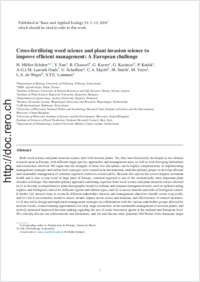Cross-fertilizing weed science and plant invasion science to improve efficient management: A European challenge
- Müller-Schärer, Heinz Department of Biology, University of Fribourg, Switzerland
- Sun, Yan Department of Biology, University of Fribourg, Switzerland
- Chauvel, Bruno INRA, Agroécologie, Dijon, France
- Karrer, Gerhard Institute of Botany, University of Natural Resources and Life Sciences Vienna, Austria
- Kazinczi, Gabriella Institute of Plant Science, Kaposvár University, Hungary
- Kudsk, P. Department of Agroecology, Aarhus University, Slagelse, Denmark
- Lansink Oud, A. G. J. M. Department of Agroecology, Aarhus University, Slagelse, Denmark - Business Economics group, Wageningen University and Research, Wageningen, Netherlands
- Schaffner, Urs CAB International, Delémont, Switzerland
- Skjoth, C. A. University of Worcester, National Pollen and Aerobiology Research Unit, Institute of Science and the Environment, Worcester, UK
- Smith, M. University of Worcester, Institute of Science and the Environment, Worcester, UK
- Vurro, M. Institute of Sciences of Food Production, National Research Council, Bari, Italy
- de Weger, L. A. Department of Pulmonology, Leiden University Medical Center, Leiden, Netherlands
- Lommen, Suzanne T. E. Department of Biology, University of Fribourg, Switzerland
-
01.12.2018
Published in:
- Basic and Applied Ecology. - 2018, vol. 33, p. 1–13
English
Both weed science and plant invasion science deal with noxious plants. Yet, they have historically developed as two distinct research areas in Europe, with different target species, approaches and management aims, as well as with diverging institutions and researchers involved. We argue that the strengths of these two disciplines can be highly complementary in implementing management strategies and outline how synergies were created in an international, multidisciplinary project to develop efficient and sustainable management of common ragweed, Ambrosia artemisiifolia. Because this species has severe impacts on human health and is also a crop weed in large parts of Europe, common ragweed is one of the economically most important plant invaders in Europe. Our multidisciplinary approach combining expertise from weed science and plant invasion science allowed us (i) to develop a comprehensive plant demographic model to evaluate and compare management tools, such as optimal cutting regimes and biological control for different regions and habitat types, and (ii) to assess benefits and risks of biological control. It further (iii) showed ways to reconcile different stakeholder interests and management objectives (health versus crop yield), and (iv) led to an economic model to assess invader impact across actors and domains, and effectiveness of control measures. (v) It also led to design and implement management strategies in collaboration with the various stakeholder groups affected by noxious weeds, created training opportunities for early stage researchers in the sustainable management of noxious plants, and actively promoted improved decision making regarding the use of exotic biocontrol agents at the national and European level. We critically discuss our achievements and limitations, and list and discuss other potential Old World (Afro-Eurasian) target species that could benefit from applying such an integrative approach, as typical invasive alien plants are increasingly reported from crop fields and native crop weeds are invading adjacent non-crop land, thereby forming new source populations for further spread.
- Faculty
- Faculté des sciences et de médecine
- Department
- Département de Biologie
- Language
-
- English
- Classification
- Biological sciences
- License
- License undefined
- Identifiers
-
- RERO DOC 323807
- DOI 10.1016/j.baae.2018.08.003
- Persistent URL
- https://folia.unifr.ch/unifr/documents/307227
Other files
Statistics
Document views: 86
File downloads:
- mue_cfw.pdf: 166
- mue_cfw_sm.pdf: 83

